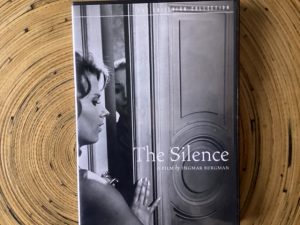That the third and last film in his Trilogy turned out to be a commercial hit was, apparently, a big surprise to the director. When I first saw it on late-night t.v. in 1969, it was the first Bergman I had seen and what made it popular and controversial, at the time , were its infamous sex scene in a theatre and its nude scenes in a weird hotel (all, incidentally, relatively tame by today’s ‘standards’).
It is, definitely, an odd psychological movie, though it pales noticeably in comparison to his classic Persona, likewise, a psychological drama between two women, which followed in 1966. And, it is the weakest–I think–of the Trilogy films because of its disunity; it simply does not come off convincingly on the single theme of the absence of God–His silence in this overwrought plot. Unlike the first two films, no religion, nor religious comfort are offered in The Silence.
There are also many loose ends: the performing dwarf troupe, the boy protagonist peeing on the hotel floor, the oddly juxtaposed American-wild-west-style ‘shootings’ by Johan, the tank that rolls through the town at night, and Ester’s sudden, inexplicable mentioning of “the smell of semen” are but five examples of the sort of irrational loose ends offered to viewers.
The setting is not uninteresting–a strange, claustrophobic Baroque European hotel during a WWII-looking wartime, where two very different sisters and the 8-9-year-old son of one of them have come to stopover before travelling home. Cinematographer Sven Nykvist effectively makes the hotel dark, mysterious, and a somewhat spooky-looking maze. Unlike previous Bergman films, his camera moves fluidly and somewhat randomly, intercutting unpredictably between the viewpoints of the three main characters.
Johan’s mother Anna (Gunnel Lindblom) is the more sensual and carnal of the two sisters. Johan’s aunt Ester (Ingrid Thulin) is the direly ill, intellectual translator, who calls out her sister for her sexual indiscretions. Johan, the perpetually curious, innocent boy moves between the two of them: being physically close to his mother, yet moved by his aunt’s situation and her more serious character. Ultimately, his point of view is the most interesting one in The Silence; Jorgen Lindstrom, as Johan, steals the movie and viewer sympathies with his looks and realistic responses to the bizarre grown-up behaviors.
In many ways, like the ticking watch which starts this film, The Silence is about time and its passing, as characters kill time existentially and absurdly. Eventually, Bergman in an overtly, too-obvious, symbolic scene has the seedy hotel porter listen to an obviously dead watch as he fails to get it running again. The porter also, ironically and symbolically, plays Johan’s ‘father’ figure and Ester’s ‘father’/’doctor’. He is the all-purpose-‘jacknife’ character in The Silence.
Re. other elements–Bergman introduces, but does not develop a vague incest sense to the scenes when Johan washes his mother’s back in the bath and sleeps half-naked with her in their hot hotel room. The director also suggests a vague lesbian motif between the two very different sisters: a theme he would come back to and bring more convincingly to fruition in Persona.
Finally, this film fails to jell coherently, unlike Through a Glass Darkly and Winter Light; it is too scattered all over the place with too many distractions, so to speak. If Bergman’s aim was to be mysterious, commercially controversial, obscure, and relatively inconsequential, then he definitely succeeded in The Silence.

